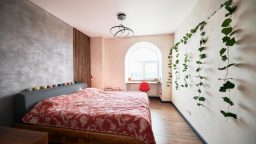Lighting is often an overlooked element of home design, yet it has the power to completely transform a space. Whether you’re aiming to create a warm, inviting atmosphere, highlight architectural features, or enhance the functionality of a room, lighting plays a key role in achieving your desired look and feel. From natural light to clever artificial lighting solutions, the right lighting can make your home feel brighter, larger, and more welcoming. Here’s how lighting can work its magic and elevate your home’s ambiance.
- Natural Light: The Ultimate Mood Booster
Natural light is one of the most effective ways to brighten up a room and boost your mood. Exposure to natural sunlight is known to improve mental well-being, increase productivity, and make spaces feel more open and airy. The key to maximising natural light is ensuring that windows are not obstructed by heavy drapes or furniture.
To make the most of the light that comes in, opt for light, sheer curtains or blinds that can be easily adjusted. You can also incorporate mirrors into your design—placing them strategically across from windows to reflect natural light deeper into the room. Consider opening up any dark corners with skylights or larger windows if possible, allowing more light to flood the space.
- Layering Your Lighting
One of the most important principles of lighting design is layering. A well-lit room typically incorporates three types of lighting:
- Ambient lighting: This is the general, overall light that fills a room. It’s usually provided by ceiling fixtures or wall-mounted lights.
- Task lighting: This is more focused light that illuminates specific areas where you perform tasks, such as reading lamps, under-cabinet lighting in the kitchen, or desk lamps.
- Accent lighting: Accent lighting adds drama and highlights specific features in a room, such as artwork, plants, or architectural details. Track lighting, spotlights, or wall-mounted sconces are perfect for accent lighting.
By combining these three types of lighting, you can create a balanced, dynamic space that caters to all of your needs, whether it’s relaxing, working, or entertaining.
- Set the Mood with Warm or Cool Lighting
The colour temperature of your lighting can drastically affect the atmosphere of a room. Warm lighting (typically between 2700K and 3000K) creates a cosy, inviting feel, ideal for living rooms, bedrooms, and dining areas. It mimics the warmth of candlelight or a sunset, making spaces feel relaxed and comfortable.
On the other hand, cool lighting (above 4000K) is perfect for areas that require focus and concentration, such as kitchens, offices, or bathrooms. Cool white light enhances visibility and provides a clean, crisp environment that can help improve productivity. When choosing bulbs, consider both the colour temperature and the function of the room to create the right atmosphere.
- Statement Lighting: A Focal Point in Your Decor
Lighting can be much more than a functional tool—it can be a statement piece that adds character and personality to your space. Bold pendant lights, oversized chandeliers, or designer floor lamps can become the focal point of a room, drawing the eye and elevating your décor.
In the dining area, a statement light fixture above the table not only enhances the room’s aesthetic but also creates an inviting atmosphere for meals and social gatherings. In a living room, a large, dramatic chandelier or unique floor lamp can add a sense of style and sophistication. Statement lighting doesn’t have to be overly ornate or expensive; even simple designs can have a powerful visual impact if positioned well.
- Highlight Architectural Features
Lighting is an excellent tool for drawing attention to the architectural features of your home. Whether it’s a fireplace, exposed beams, or an intricate ceiling, lighting can accentuate these elements and make them stand out.
For example, wall-mounted sconces can be placed on either side of a feature wall to create a warm, inviting glow. Recessed lighting or spotlights can be installed to highlight artwork or a collection of bookshelves. Up-lighting can illuminate tall architectural features such as columns, creating a dramatic effect. By strategically placing lights, you can showcase the unique elements of your home while also enhancing the overall ambiance.
- Create a Welcoming Entryway
The entryway sets the tone for the rest of your home, and lighting can play a significant role in creating an inviting first impression. A well-lit entryway can make your home feel more welcoming and open. Use a combination of overhead lights, such as a pendant or chandelier, and task lighting, like a wall sconce or table lamp, to create a layered effect.
Consider adding accent lighting to highlight artwork or a beautiful mirror, and make sure the lighting is bright enough to illuminate the space without feeling harsh. A well-lit entryway ensures that guests feel comfortable the moment they step into your home.
- Make Small Spaces Appear Larger
Lighting can work wonders in making small spaces feel larger and more open. One of the easiest ways to do this is by using plenty of light—both natural and artificial. Bright spaces feel more expansive and less cramped, so avoid dark, heavy lighting that can make a room feel smaller.
Mirrors, placed strategically in small rooms, can also amplify light and create the illusion of space. Choose light-coloured walls and furniture that reflect more light, and avoid overcrowding the space with bulky furniture or dark décor that absorbs light.
- Use Lighting to Define Zones in Open Plan Spaces
In open-plan living spaces, lighting can help define different functional areas while maintaining a cohesive look. For example, you can use pendant lights or chandeliers to designate the dining area, while floor lamps or table lamps can create a more intimate atmosphere in the living area.
Accent lighting, such as LED strip lights or wall-mounted sconces, can further enhance different zones, giving the space structure without needing to build walls or partitions. This creates a flow between the areas while still maintaining their individual identities.
- Control Lighting with Dimmers and Smart Technology
To adjust the ambiance and make your lighting more versatile, consider installing dimmer switches or using smart bulbs that allow you to control brightness and colour temperature. Dimmer switches let you easily transition from bright, task-oriented lighting to soft, ambient lighting depending on the time of day or activity.
Smart lighting systems can also be programmed to change with your routine. For example, you can have your lights automatically brighten in the morning to wake you up gently and dim in the evening to create a relaxing environment for winding down.
- Consider the Environmental Impact
As you choose lighting options for your home, keep energy efficiency in mind. LED bulbs are a great choice as they use less energy, last longer, and are available in a range of colour temperatures. Consider investing in energy-efficient lighting throughout your home to reduce your carbon footprint while also saving on energy costs.
Additionally, solar-powered lights for outdoor spaces or motion-sensor lights for areas like hallways or bathrooms are great eco-friendly options that can further enhance the sustainability of your home.
Conclusion
Lighting is one of the most transformative elements in home design. Whether you’re brightening up a dark room, adding character with a statement fixture, or using lighting to create ambiance and define spaces, the right lighting can completely change the way you experience your home. By considering factors such as natural light, colour temperature, and layered lighting, you can create a home that is both functional and aesthetically pleasing. With the right approach to lighting, you can create a space that feels warm, inviting, and perfectly suited to your lifestyle.





